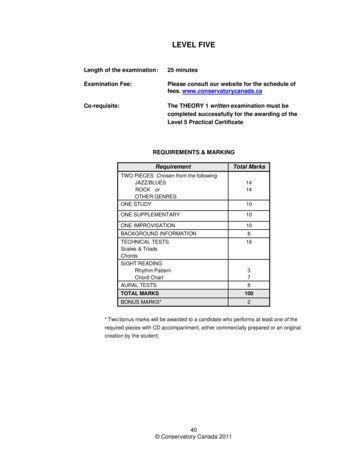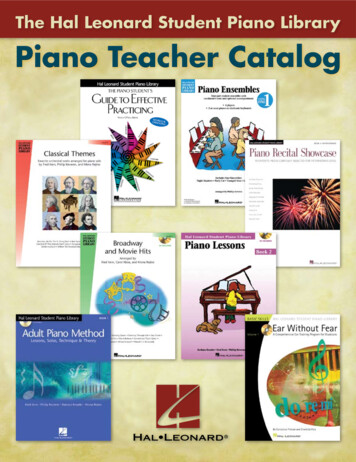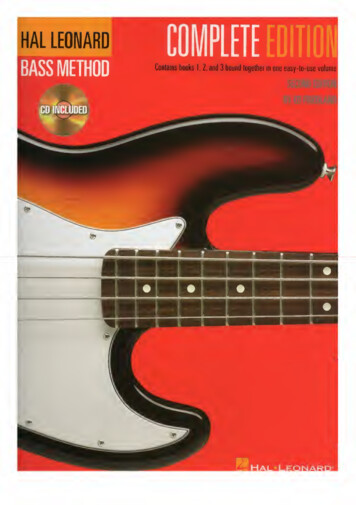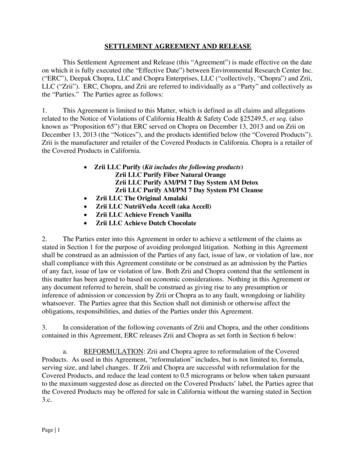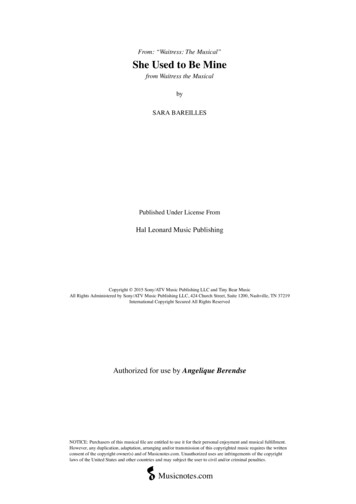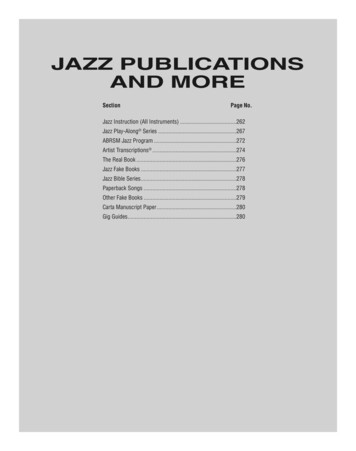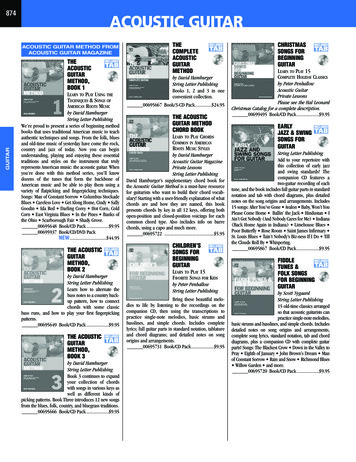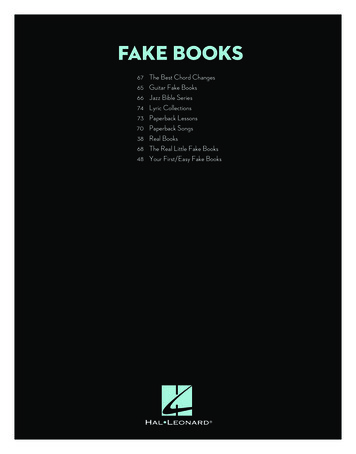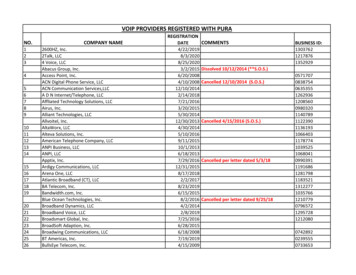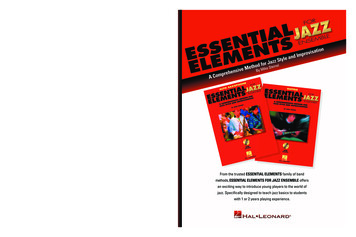
Transcription
A ComprehensiveMethod forBy Mi Jazz StylekeSteineland ImprovisationyletSzzr Ja inelofdoMeth By Mike SteevishenerpmA CotionasivpromIdnaFrom the trusted ESSENTIAL ELEMENTS family of bandmethods, ESSENTIAL ELEMENTS FOR JAZZ ENSEMBLE offersan exciting way to introduce young players to the world ofjazz. Specifically designed to teach jazz basics to studentswith 1 or 2 years playing experience.#73999-DCAAGaHL90001883Visit Hal Leonard Online atwww.halleonard.com
59271EEJazz[guts]:12/2/084:36 PMPage 1DIRECTOR’S INFORMATION GUIDEESSENTIAL ELEMENTSFOR JAZZ ENSEMBLEA COMPREHENSIVE METHOD FORJAZZ STYLE AND IMPROVISATIONBy MIKE STEINELWELCOMEto the exciting world of jazz! This book will help you get started by introducingthe important elements of jazz style and improvisation. You’ll also learn basic jazz theory andsome highlights of the history of jazz.The exercises and compositions in this book can be played by a full jazzensemble, or individually with the CD. Listening to good jazz players isan extremely important way to learn, and playing along with the CD is anexcellent way to hear how jazz is played. The full band arrangements inthis book include “sample” improvised solos for study and reference.And remember have fun playing jazz!ABOUT THE AUTHORMike Steinel is an internationally recognized jazz artist and educator. He has recorded with theFrank Mantooth Orchestra and the Chicago Jazz Quintet, and performed with a wide variety ofjazz greats including Clark Terry, Jerry Bergonzi, Bill Evans, and Don Ellis. Since 1987, he has beena member of the jazz faculty at the University of North Texas where he teaches jazz improvisationand jazz pedagogy. He is the author of Building A Jazz Vocabulary (a jazz text) and numerouscompositions for jazz ensemble.The University of North Texas pioneered jazz education when it instituted the first jazz degreeprogram in 1947. Its flagship ensemble, the One O’clock Lab Band has toured four continentsand has been the recipient of four Grammy nominations. Throughout its history, UNT has produced a host of fine jazz talent. Alumni of the program can be found in all facets of jazz andcommercial music.Managing Editor:MICHAEL SWEENEYCopyright 2000 by HAL LEONARD CORPORATIONInternational Copyright Secured All Rights Reserved
59271EEJazz[guts]:12/2/084:36 PMPage 22 CDs WITH EVERY BOOK4One of the most important ways to learn to play jazzis by listening to professional players. Each bookcomes with complete recordings of every exampleand every full band arrangement. On the repeatedexercises, the rhythm section only plays the secondtime. This allows students to hear the correctinterpretation the first time, then play along thesecond time. The full band arrangements include“sample” improvised solos recorded on separatetracks for study and reference.YLEOF JAZZ STTHE BASICSReleasesAttacks andc (ConcertIn traditional musi) you use aBand and Orchestran to begin a note“Tah” articulatioat the end.and taper the note .ŒDoo - - - itTahœ ‰ ŒJJazzœ ‰ ŒJtiona .&ŒAND RELEASES1. ATTACKS l4 Tradiw&4” attack (softon to use a “DooIn jazz it is commcommonn a note. It is alsoand legato) to begiThis “tonguewith the tongue.to end the notemic feeling.rhythacmusistop” gives theJazzTraditional&wÓSwing 8thTraditionalNotesIn swingSound, the 2nd 8th notriplet,Difante of eaanslidgh4”ch beattime are ferent Thtly acce beatAccenting “2 cd theis actuallnted. 8ts in 4/4rtantan Thimpol musih no beats 2 y playeey4 Lood likeFor most traditionahasis is usually ontes in sw32khowever, the empfeeling.ing style are us 1 the last1 and 3. In jazz,the music a jazzually pla third of aing “2 and 4” givesyed leghasizSWand 4. Emp6.ato.ING 8TTradition H NOTESal D 4Sing the2 ANscat syl Jazzlables of2. ACCENTINGeach exercise beTraditionalfore youplay it.Tah TahJazzTah TahTah& 44 œ. œ. œ. œ. . œ œœœœ&Tah5œ œ œœ œ or 3 j œ œ . œ Œ œÓ œ3STARTS WITH THE BASICSœ œ- œ œ- œ œAccentœTah Tah4321 œ œ œ . .œœœ œ œ. œ.œ . œ œœ Œ - œ œ œ- œ Tah TahTah-œŒœ œ œ œ œJazz œ œ œ œ&4 œ&4.Óit- - - - - Doo - - - -ŒNotes)Doo Bah DooQuart o and Bah (Full ValueBah Doer Novaluet tog DoPlayinTenuQuartertes (tenuto) or an accent are played fullnote with a dash” and “Bah” will(full value)Long, accented)Doo(fullBah valueDoo Bain swingdenotes marksedh Dotsyllables “DooBahtacheIn jazz,styd (stacarticThe scat (vocal)isn. leDooo catoulatiousually ns. Remember in jazz it) with ac arewith a soft legatplayedarticulatiount of accent.centof theseamodten.sounopriasulatiotheon legatapprarticats 2o anhelp you heardemonstrate thes with nt to playvocalizing the scatis used only when le “Dah.”“Bah” articulation7.: TheNoteQUARTER on your instrument use the syllabS ANWhen articulating&œœ& 44 œ. œ . D 8THSœ Œœ- œ œ- œ œŒDitDotœœ& œ.œ Ditœ.DitDoo Bah DooBah Dot8. MORE QUARTERS AND8THSœ Ditœ.Dotœ.Dotœ DitDotœ- œ œ- œ œŒDitStudents are shown how the approach to jazz isdifferent than “traditional” music step by step. Withthe help of vocal “scat” syllables, the correct styleinflections come naturally. The concept of swing 8thnotes is taught gradually, using single pitches to startwith, then reinforced using easy scale patterns.Œ.ŒDoo Bah DooBah DotEASY INTRODUCTION TO JAZZ HARMONY11s (every other notechords built in thirdChordsds are four-noteBuilding Jazzd with Seventh Chords. Seventh Chorscale.notes of a majoronizefifth, and sevenththird,Most jazz is harmfirst,theusesChordA Major SeventhChordC Major Seventh31.4C Major Scale&4 œœœœœœœœœœœ5318765of a scale).œœœ 7531One of the most challenging elements of jazz islearning the concept of jazz chords and harmony.Chords are taught by showing how they relateto familiar scales. Only the basic types are shown(major 7th, dominant 7th, minor 7th) and theyare immediately reinforced with a series ofsimple exercises.wwwwnth Chord.21to a Dominant Seved.d changes the chord the chord to a Minor Seventh Chorr Seventh Chorchangesseventh) of the Major Seventh Chordnote (called the(seventh) of a MajonotetopLowering the topandd (called the third)ChordLowering the seconC Minor Seventhth ChordC Dominant SevenChord32.C Major Seventh43œ4&4 œ œ œœ bœœ œœ œ œ bœœ bœœ œ œ bœ the root or thealways indicatesa Chord Symbolnant for example).The first letter intype (major or domiChord Symbols.indicate the chordfic labels calleders on the rightChords have speciletters and numbThe.chordtheolChord Symbbottom note ofChord NameCma7C7Cmi7C Major SevenththC Dominant SevenC Minor SeventhUT37. BLUECHORD WORKOS ENTWOHRKSEVOUT – Ro33. MAJOR 7ots4 4& 4& 4 œ C. -œ b œ (Cma7 ) . -‘‘ ( 7)C7WORKOUT CENTH CHORDDOMINANT SEVG734.&4 .œ œ b œ b & 4 - 38. .œœœœœ œ and Seve œ œ sœ nthwF7‘ . .œœœ wœœ œ œ œ b œ . - bœ. œ -œ œ w 7œ œ œF.œ w -œ œ . - œ œ b. - œ ‘ ‘‘C& nœ œ œ b œ ‘G7.œ -œ b œ ‘F7œ œ œ bœ C7F7œ nœ œ œ Solo&’ ’ ’ ’œbœ œBuilding the‘œ nœ œ bœ Œ . .œ œ œ bœ 39. MAKEUP YOUR OWN – 2-BC 7 Bandar Solos us ing Roots, Thirds, an&Solod Sevenths7 Ban44 œ œ œ b œ œ œ œ œ œ œ . - b œ C7(Play either note)C7. BLUES WO RKOUT –Roots, Th(C 7 )C7irds, and Sevenths&44 œ œ œ bœ 7IMPROVISATION MADE EASY(Play either note)œ. -œ œœ ww‘ .Œ .’’’’dF’’’’ œ œbœ œ œœœ b œ œ œ œ œ. -œ b œ 7G 7 Band’ ’ ’ ’ œ nœœ œ Fœ œ œ bœ DominantYou can builScaled a “dominantscale” by inseThis scale “fitsrting notes” (sounds likebetwee) the D hC7Solo’ ’ ’ ’bœ œ œ’ ’ ’ ’ .Building on the concept of jazz chords, the BluesProgression is taught as a series of dominant 7thchords. Improvisation is introduced gradually,starting with 2-measure phrases using only a fewchord tones at a time. Students are improvisingbefore they have a chance to be worried about it!They are shown how jazz first evolved around“jazzin’ up” the melody, and are taught basic scalesto use when improvising - Blues Scale, Dominantor Mixolydian Mode, Bebop Scale, and theDorian Mode.
59271EEJazz[guts]:12/2/084:36 PMPage 3ted aher Henderson crean Miller, and Fletcy Goodman, Glenic of the time., Count Basie, Bennmost popular musthegtongEllineswineDukmadofsband” sound40’s, the orchestraand smooth “bigIn the 1930’s andg. The strong beatlyDuke Ellingtone music called swinand led a band nearnew type of dancin Washington, D.C.and9–1974) grew up(189his compositionsgtonEllin“Duke”t remembered formosisheEdward Kennedyedist,iderpiangiftedEllington is consough Duke was athousand works.all of his life. Althhe wrote over oneury.is estimated thatr of the 20th centorchestrations. Itortant jazz composeimptmosthebeby many toBank,e was born in RedCount BasieWilliam “Count” Basibig band music4), but his style of’s,New Jersey (190. In the early 1930CitysasKanis associated withestra, a “riff”Bennie Moten OrchtheedjoineBasiing the bluesspecialized in playstyled band thatt. Whenarily in the midwesand performed primover thethe “Count” tookMoten died in 1935onemebecaitiphis leadershtertaining showband, and underthe era. Evenmade him a recognizable figure theman.world over.ular jazz bands ofof the most popeBasintCouh in 1984, Theafter Basie’s deatand please jazztourtodinuecont99. “BOestraOrchPPIN’ AROUND” –world.the Full Band Arrangement# audiences%aroundThe Swing EraJAZZ HISTORY AND PEOPLEThe method book is laid out chronologically byimportant historical periods in the development ofjazz music. While the students are learning themusic, they are also learning about the importantcomposers and performers associated with eachstylistic period. Styles covered: Early Jazz, SwingEra, Bebop, Latin and Fusion.PERFORMANCE SPOTLIGHT& 44 Œ Œ . œ #œ œ œ nœMike Steinelœ nœ œ œ bœŒ œ bœ nœœ .œ œ œ œ œ nœ . œ œ bœ œ Œ Œ œbœ nœ œ - œœ œ œ œ nœ œ œ Œ#- œ1.To Coda& œ # œ n œ œ œ œ œ # œ œ. # œ n œ fi 2. div. Œ œ bœ nœ œ {14} Solosœ œ œ œ n œ œ Ó . œ œœ # œ n n œœ œœ Ó# G7& . w w w w w w n w # w wC7’’’’ ’’’’’’’’# G7w w w nw w w b w n w w ’ ’ ’ ’D7& w w w w w w nw # w w7’’’’w w w w # w w ’ ’ ’ ’ G w w w w w n w # w w D.S. al Coda#wwwwfi CODA’ ’ ’ ’ .# & Œ œ bœ nœ œdiv.œ œ œ œ nœ œ Ó Œ œ bœ nœœ œ œœ œœ Óœ œ100. DEMONœSTRATION SOLOFOR“BOPPIN’ ARO# G7 œ œ n œ œUND”œ œ œ bœ& 44 ŒC7œÓnœ œ œ nœ œ œ #œ nœœ ‰ œjœ œ b œ œ œ b œ œ n œ Œ ‰ œ# G7 œ œ7JD#nœœ&œ n œ# œ œ œ b œ œG7 Œ œ œ œ œ œ #œ nœ œœ œbœ œ nœ œ7 #Gœ œ œj œ .& œ œ#œ œ œ#œ œ nœ œ C7œ œ œ œ . œj œ œ œ bœ œ œœŒœbœbœ bœ bœ# G7D7& n œjœ .œ Œ Ó Œ ‰ œ œ œ œ œ œG7Jœ n œ # œj œ . n œŒ œ œ œ .#33& œ nœ #œ œœ nœ œ œ œ bœ12A7 FULL BAND ARRANGEMENTSCarefully paced throughout the book, these fullarrangements provide a focal point for the materialin each unit. They also provide rewardingperformance pieces even in the beginning stages.The arrangements start out very easy and thengradually progress in complexity as moretechniques and concepts are learned.QUICK START THE RHYTHM SECTIONCritical to the success of any jazz ensembleis having a rhythm section that can play in astylistically correct manner. In addition tolearning concepts along with the otherinstruments, each rhythm section book includesadditional material specifically designed toaddress the unique techniques of these importantplayers. This allows the rhythm section to playalong with the full band in a rehearsal setting,but also gives each player the individualizedinformation they need.FOR PIANO ONLYJazz Chord Voicingswhich notes are usedways. The way a specific chord is played andJazz Chords can be played many differentor as many as eight or more.Jazz voicings can have as few as two notes4C ma7ntThirds and Sevenths are Importaminor,These notes determine the quality (major,thisor dominant) of the basic chord. Notice inonlyexample how simple voicings made up ofcomplete.roots, thirds, and sevenths sound full and&4 w 3? 4 ww 7Root4C mi7w3bw 7w Rootbw 3bw 7w RootNinths, Elevenths, and ThirteenthsExtended C Major Scale ww w4 w w w w&4 woftenTo make jazz voicings sound jazzy, pianistsandinclude upper extensions (ninths, elevenths,arethirteenths) in the chord voicing. These notesnotes ofthe same pitches as the 2nd, 4th, and 6ththe major scale from which the chord is built.Note: Ninths and thirteenths can be added810911even though the chord symbol indicatesComping With Jazz Voicings12is called a Voicing.C71314C Major Thirteenth Chord(C ma 13 )wwwwwww15a seventh chord.6Athe rest of the band. In order to achieve this,must compliment and not compete withIt is important to remember that “comping”information with the least amount of notes.that supply the most necessary harmonicpianists and guitarists improvise chord voicingsFOR adequateThe Ride or four-note combinations. These providean DRUMS ONLYtwo-, three-, Cymbalto start withbestisitchords,voicetolearningfirstInWhen you aremarkedharmonized three different ways.progressiona bluesisjazz“swing” thethick or muddy. Heresupride cymbalpicture of the harmony without soundingply the rhytreinforces thehmic foundatiquarter note walon of swingking bass linemusic.provided bythe bass player. These twoinstrumentsBb 7Eb 7F7The BaBsic337Ride Cymb 7373The7alride cymbalPattern3pattern is usufaster temposally played ina triplet feelthe eighth not, however ites are playedis not alwaysmore evenly.strict. At slowIn this booktempos theThe basic Ridewe will alwayspattern is verynotate the rideCymbal Patttriplety butern is andhs)pattern in eighnotthirteentatatedninths,,as:th notes.(thirds, sevenths(thirds and sevenths)Blues in Bb using two-note voicingsb7b7Bb 7w3? b 44 b w 7b‘‘‘bEww 7Blues in Bb using three-note voicingsThese voicings are used for exercises 37–39Bb 7b4& b 4 ww 133‘‘and 41–45.‘Eb 7‘b ww‘wnwb wwEb 7b 7 bal PatternF7BCymsounds likeThe basic Ride‘ ww 97n ww 133b ww 97The BasicbSwing Pa n‘:b ww 97b ww‘ 44 ‹‹ ‹ ‹ ‹ ‹Bb 7 44 ‹ w 3 ‘3n w 133‹ ‰ ‹ ‹ ‹ ‰ ‹bttern – PlaThis is the basic swing pattying “timeern for Jazz”Drumming(with and without bass drum). Practiceeach until they 44 œ‹ ‹ ‹ ‹ ‹ ‹ .‹œ œ ‹œ .AchievingVa i t 44 ‹ ‹ ‹ ‹ ‹ ‹ .Œ ‹ Œ ‹ .are “automatic”.
59271EEJazz[guts]:12/2/084:36 PMPage 44THE BASICS OF JAZZ STYLEAttacks and ReleasesTraditional& .In traditional music (ConcertBand and Orchestra) you use a“Tah” articulation to begin a noteand taper the note at the end.Jazz& .ŒTahIn jazz it is common to use a “Doo” attack (softand legato) to begin a note. It is also commonto end the note with the tongue. This “tonguestop” gives the music a rhythmic feeling.ŒDoo - - - it1. ATTACKS AND RELEASESTraditional4w&4JazzœJ ‰ ŒwÓTahœJ ‰ Œ.ÓDoo - - - - - - - - - - itAccenting “2 and 4”Traditional 13 Jazz œœœœ&&œ œ œ œFor most traditional music the important beats in 4/4 time are1 and 3. In jazz, however, the emphasis is usually on beats 2and 4. Emphasizing “2 and 4” gives the music a jazz feeling.2412342. ACCENTING 2 AND 4Traditional 4&4 œ œœ œœ œœJazzœœœ œœ œ œœ . œ Œ Ó-œœ Tenuto(full value)Long Accent(full value, accented)DooBahPlaying Doo and Bah (Full Value Notes)In jazz, notes marked with a dash (tenuto) or an accent are played full valuewith a soft legato articulation. The scat (vocal) syllables “Doo” and “Bah” willhelp you hear the sound of these articulations. Remember in jazz it isimportant to play full value notes with a legato articulation.œNote: The “Bah” articulation is used only when vocalizing the scat syllables.“ Bah” helps demonstrate the appropriate amount of accent.When articulating on your instrument use the syllable “Dah.”3. DOO AND BAHTraditional 4&4 Tah Jazz œœ TahTahTahTah œœ DooDooDooBahDoo4. DIT AND DOTTraditional.4&4 œ Œ œTahœ. œ. œ. ŒŒTahTahTah5. DOO, BAH, DIT, AND DOT4 -̇&4Doo-̇Doo-œ œ DooBahTahœ Staccato(short, unaccented)Roof Top Accent(short, accented)DitDot-œ œ DooBahœ. œ œ. œ DitDitœ.DitDitŒœ.DitŒŒDoo - - - - itœ. Œ œ. ŒJazzœœ.Playing Dit and Dot (Short or Detached Notes)In jazz, notes marked with a staccato or a roof top accent are abouthalf of full value. The scat syllables “Dit” and “Dot” will help you hearthe sound of these articulations. DotDitDotœ.œ œ.œ DitDotDitDot. œ Œ ÓDot. œ DotŒÓ
59271EEJazz[guts]:12/2/084:36 PMPage 55Swing 8th Notes Sound Different Than They Look3œ œ œ œ œ In swing, the 2nd 8th note of each beat is actually played like the last third of atriplet, and slightly accented. 8th notes in swing style are usually played legato.6. SWING 8TH NOTES Sing the scat syllables of each exercise before you play it.Traditional. . .4&4 œ œ œœ. œ.œ. œ. œ. œ. œ.ŒTah Tah Tah Tah TahTah Tah Tah Tah TahQuarter notes in swing style are usually playeddetached (staccato) with accents on beats 2 and 4.7. QUARTERS AND 8THSDitœ œ.DotDitŒDit œœ.œDotDitDotImportant Tip: Ó-œ œ -œ œDoo Bah Doo DotThese are the four basic articulationsin jazz and the related scat syllablesfor each.Quarter notes in swingstyle jazz are usuallyplayed staccato.œ œ.œ DotDitDot-œ œ -œ œ œ Œ.&œ œ œ.DitDotDit œ.œDitDotŒŒ Ó-œ œ -œ œ -œ œ -œ œDoo Bah Doo Bah Doo Bah Doo Dot-œœ.œ œ Tenuto(full value)Staccato(short, unaccented)Long Accent(full value, accented)Roof Top Accent(short, accented)DooDitBahDotStaccato. œ œ. œ œ&DitDotDitDot.Doo Bah Doo Bah DotNotes at the ends of phrases are usually played short and accented.Jazz Articulation ReviewQuarter Notesœœ.ŒDoo Bah Doo Bah Dot œ Doo Bah Doo Bah DotDit-œ œ -œ œ œ 8. MORE QUARTERS AND 8THS4& 4 œ.œor-œ œ -œ œ œ ŒDoo Bah Doo Bah Dot&œQuarter Notes4.&4 œ-œ œ -œ œ œ JazzŒjœ œ3Legato-œ œ -œ œ -œ œ -œ œ Doo Bah Doo Bah Doo Bah Doo BahSwing 8th Notes8th notes in swingstyle jazz are usuallyplayed legato.
59271EEJazz[guts]:12/2/084:36 PMPage 669. SWINGIN’ THE SCALE-œ œ -œ œ œ œ œ œœœ- - -œ œ -œ œ -œ œ œ œ œ œ -œ œ -œ œ - œœœ - - Doo Bah Doo Bah Doo Bah Doo Bah continue sim.Doo Bah Doo Bah Doo4&4œ10. MOVIN’ AROUND4&4 œ.œDitDot&œ.Dit -œ œ -œ œ -œ œ -œ œ Doo Bah Doo BahDoo Bah Doo Bah Dooœ.œ-œ œ -œ œœ-œ œ - œ DitDotDoo Bah Doo BahDoo Bah Doo Bah DooDitœ-œ œ - œ -œ œ -œ œ œ.œDotDoo Bah Doo BahDoo Bah Doo Bah DooDoo Bah Doo Bah DitDot -œ œ -œ œ -œ œ -œ œDoo Bah Doo Bah Doo Bah Doo Bah Dooœ Dotœ-œ œ -œ œ œ- œ -œ œDotDoo Bah Doo BahDoo Bah Doo Bah Doo12. TRADIN’ OFF4&4 Trumpetsœ- œ -œ œ œ.Trombones& œ œ -œ- œ œœ- Doo Bah Doo Bah DitDotœ- œDooDit& œ #œ œ œ œ- - .Doo Bah Doo Bah Dit& -œDooDoo Bah& œ œ œ œ œ.- - Doo Bah Doo Bah DitDitDotDoo Bah Doo BahDoo Bah Doo Bah Dooœ.Doo Bah Doo Bah Dit -œ œ œ œ œnœDot œDitDot œDotœ-œ œ -œ œ . œDoo Bah Doo Bah Dit DotŒn -œ œ œ. DooBahDitœ-œ œ -œ œ .Doo Bah Doo Bah DitœDooœ-œ -œ œDot Doo Bah Doo Bah Doo -œ œ œ Doo Bah DotBob Carletonœ. .œ. .DitDitŒ ÓDot Doo Dooœn -œ œ œ Doo Bah Doo Bah DitDotDoo Bah DotDoo œ.DooDitŒ.Doo-œ œ -œ œ # œ.ÓDot . Doo Bah DotDoo Bah Doo Bah Doo Bah Doo Bah Dooœ œ œ #œ - .Bah œ- œ -œ œ-œ œ -œ œ -œ œ -œ œ Doo Bah Doo Bah Dooœ. . .-œ œ -œ œœ œ œ-œ - 13. JA-DA4&4 œ.œAll SectionsœDooœ.Doo Bah Doo Bah Doo Bah Doo BahDoo Bah Doo Bah Doo. Doo Bah Dot-œ œ -œ œ -œ œ -œ œ -œ œ -œ œ Dotœ. SaxophonesœDoo Bah Doo Bah DitDit-œ œ œ-œ œ -œ œ4& 4 œ.&œ œ11. RUNNIN’ AROUNDDit . .œ. .DooDitDooœ-œ œ -œ œ .Doo Bah Doo Bah Dit œDot œDotŒ Ó
59271EEJazz[guts]:12/2/084:36 PMPage 77When beats are played early (anticipated) or played late (delayed),the music becomes syncopated. Syncopation makes the music sound “jazzy.”Syncopation in Jazz14. SYNCOPATING BY ANTICIPATING THE BEAT (PLAYING EARLY)4&4 œ J(Syncopated) œ.œ œ.(Syncopated) -œ œ œ. AnticipatedAnticipated15. SYNCOPATING BY DELAYING THE BEAT (PLAYING LATE)4&4 (Syncopated) ‰ œ.œ œ. (Syncopated) ‰ -œ œJ DelayedDelayed16. WHEN THE SAINTS GO MARCHING IN – Without Syncopation4&4 Œœ.&Œœ.œ. œ.œ.wœ. Œ wœ.œ.œ. James Black and Katherine PurvisŒœwÓ17. WHEN THE SAINTS GO MARCHING IN – With Syncopation4&4 Œ &Œœœ.DotDitœœ.DotDit-œ œDoow ŒBah-œ œ œ.Doo BahDoojœ Bahœœ.DotDit-œ œDooBahjœ wœ.œ DooDoo Bah-œ œ .Doo Bah-œ œ -œ œ œ. -œ œ . Œ œ- œ -œ œ œ. œ Doo Bah Doo Bah Dit Doo BahDoo Bah Doo Bah Dit19. JA-DA – Full Band Arrangement – With Syncopation4&4 œ-œ . & œ# œ œ œ œn -œ œ -œ œ œ. & nœ œ œ œ n -œ œ -œ œ -œ œ .œ-œ œ -œ œ . -œ œ . œ-œ n œœ .œœ œœ .- Œ -œ œ -œ œ # œ. œ# -œœ # œœ . Œ ÓBah18. RHYTHM STUDY FOR JA-DA4- &4 œ œ .wDotDoo Bah Doo BahBob CarletonArr. by Mike Steineldiv.Œ-œ œ -œ œ # -œœ # œœ .œœ œœ .- div. œ œ œ œ #œ œ-œ œ -œ œ # œ. œdiv.œ .Œœ- œ -œ œ œ. b -œœ œ . n -œ œ -œ œ
59271EEJazz[guts]:12/2/084:36 PMPage 8820. READING SWING RHYTHMSTo play the correct rhythm with a good jazz feel, think (or feel) the basic 8th note pulse and the jazz syllables.To play the correct rhythm think( œ œ œ œ ) of the underlying 8th note pulse.(œ œ œ œ)4 &4 œ œ œ œ ÓDoo Bah Doo DotDooTo play the correct feelthink of the jazz syllables. &œ œ œ œ Ó(œœ Doo Dotœ-œ œ -œ œ DitDot Doo Bah Doo DotDitDitDot Doo Dit22. SWING RHYTHM WORKOUT #2 œ œ œ œ œ.Œ Doo Bah Doo Bah Dot œ)Ditjœ- œ . &œ œ œ œ œ Doo Bah Doo Bah DotŒ& œ œ œ œ œ. Doo Bah Doo Bah Ditœ œœ.Doo BahDooDoo Bah œ œ ÓDoo Dot œDot jœ ÓDotœ)Dot Doo Dotœ. œ -œ .œ JDit Dot DooDotœ. œ -œ œ.J DotDitDot Doo Dit œ œ œ œ œ. œ œ œ œ œ œ Jœœ.DotDooŒ Doo Bah Doo Bah Dotjœ œ œ œ -œ œ . Doo Bah Doo Bah Doo Bahœ œ DitDoo Bahœ.Dooœ JBah24. SWING RHYTHM REVIEW4.&4 œ& œ.- & Jœ œ .œ œœ œ œ œ œ œ œ œ jœ- œ. ‰ œ œ œ œ œ -œ œ. ‰ œ œ œ œ œ Jœ œ.J Doo Bahœ œ œ œ œ. œ-œ œ .J-œ-œ. jœ ÓDot j‰œ Ó-œ œ.Doo DitDot j‰ œ Ó-œ œ.Doo Dit.Dotœ)œ œ. ‰ œ JDoo Ditœ œ. Dot23. SWING RHYTHM WORKOUT #3 Remember to keep the 8th note pulse going in your head.(œ œ œ œ)(œ œ œ œ)(œ œ œ œ )(œ œ œ4.&4 œ (œ œ œ œ)Doo Bah Doo Bah DitŒœ(œ œ œ œ)œ- œ œ. œ -œ œ. ‰ œ J Dot Doo Bah4&4 œDot DooœDoo Dit(œ œ œ œ). - & œ œ Jœ œ .Dit(œ œ œœ. œ -œDotœ œ. ‰ œ ÓJDoo Bah Doo Dot (œ œ œ œ )(œœ œ œ œ ÓDoo Bah21. SWING RHYTHM WORKOUT #1. œ 4œ&4Doo Óœ ÓJœ.Doo Bah Doo Dotœ)œ œ.JDoo Bah Doo Dotœ œ œ œ Óœ œ Óœ.Bahœ œ œ œ jœ. ‰ œ œ œ œ œ œ. ‰ œ œ œ œ œ J.
59271EEJazz[guts]:12/2/084:36 PMPage 99”Jazzin’ Up” the Melody with SyncopationSyncopation is the first step to improvising in a jazz style. Early jazz musicians syncopated all types of music,including marching band tunes, hymns, and blues songs. They called it raggin’ the melody.25. “JAZZIN’ UP” A-TISKET A-TASKET Original Melody4& 4 œ. œ œ. . Jazzed Up (syncopated) Melody& œ. DitœDitDotDoo Bahœ œœ.Dit Dit &œ.œ œœ.Doo œ œ. œ. œ œ œ œ Œ œ. œ œ œ œ. œ .DooDotœDoo Bahœ œœ.Dot DitDoo Bahœ œ œ.œœ.DooDitDotDitœBahœ Dit œœ œœ. œ. œ œ œ œ.DooŒœ.Dit œBahDot”Jazzin’ Up” the Melody by Adding RhythmsAdding rhythms to a melody is another easy way to improvise in a jazz style. Start by filling out long notes withrepeated 8th and quarter notes. Remember to swing the 8th notes (play legato and give the upbeats an accent).26. “JAZZIN’ UP” JINGLE BELLS4Original Melody &4 œ œ . œ. œ œ. œ œ œ w.œ. œ œ. œ œ. œ œ œ œ œ œ œ œ œ œ . œ. œ œ. œJ. PierpontwJazzed Up Melody (rhythms added)&œ œ œ œ Doo Bah Doo Bah BahDoo Bah Doo Bah Ditœœ œ œ œ.œ œœ œ œ œ œ. DotDoo Bah DotDitDoo BahDoo Bah Doo Bah Dit&œ œ œ œ œ .Doo Bah Doo Bah DitDoo Bah Doo œ œwœ œwDooDooBah BahMAKE UP YOUR OWN (IMPROVISE)27. LONDON BRIDGE Complete the melody in your own “jazzed up” way. Use only the notes shown in parentheses.Original Melody4& 4 œ. Slashes on the staff indicate when to improvise. œ œ œ œ œ .Jazzed Up MelodyBand œ. œ Solo& œ œ œ œ. œ œ œ œ (’œ œ’œ)’ ’. Band &œœœ œœœ œœœœ œ œ œ œ œ. œ œ. œ œ œ .œ. œ Band’’’’ œ œ œ œ œ .( œ œ œ) œ œ œ œ œ. .Soloœ. œ œ ’’’’’’’’œ(œ œ )(œ )Solo – complete the melody’’’’ ’’’’ ’’’’ ’’’’Helpful Hint: Using The Melody Is Never WrongWhen starting to improvise, keep the melody in your mind. It is a helpful guide for beginning improvisers.
59271EEJazz[guts]:12/2/084:36 PMPage 101016Improvising on the MelodyJazz musicians often improvise “on” or “around” the melody of a song. There are many ways to change a melodyto create an improvisation.53. ST. LOUIS BLUES – Original Melody#4 œ& 4œ œœ #‰ j œ œ b œ. -œ œ w#œ .& wŒ .œœœœ Œ‰ b œ œ œ œ. -œ œ wJ œ œ œ œ 54. ST. LOUIS BLUES – Changing Rhythms,#& w jœ. œ- œ œ œ œ œ b-œ œ. ‰ œ w .Œ‰ j œ œ b œ. -œ œ#œ .œ. œ. -œ œ œ .Œ œ. œ œ. œ œ œ # œ œ œ b œ œ œ œŒ‰ b œ œ œ -œ œ. ‰ œj wJ .Œ55. ST. LOUIS BLUES – Repeating Parts of the MelodyWhen there are pauses in the melody, repeat notes or groups of notes.#4 œ.œ& 4 œ œ œ œ œ œ œ œ œ b œ -œ œ b œ -œ œ . #& w .Œœ œ œ œ œ œ œŒœœœœœœœ‰ bœ œ œ œ œ œ œ wJb œ.œ. œ œ -œ œ .Œ56. ST. LOUIS BLUES – Filling in the SkipsSkips in the melody can be filled in with the scale steps.# 4 . œ. œ œœ œ œ œ œ œ œ bœ œ w& 4œœ#& w .Œœ œ œ œ œ œ œ. .Œœœœœ b œ. -œ œ wœœœœ b œ. -œ œœœœœ .Œ57. ST. LOUIS BLUES – Adding “Wrong” Notes (Chromatic Ornamentation)A “wrong” or dissonant note (usually a half step off ) can create a great jazz effect if it leads into a “good” melody note.# 4 . œ .& 4 œ b œ n œ œ œ œ œ # œ œ œ b œ -œ œ w #& w .Œa œ n œ # œ. œ œ œ .Œb œ.œ # œ œ. œ œ œ œ œ œ œ œ -œ œ b œ œ œ œ œ. -œ œ w .Œ
59271EEJazz[guts]:12/2/084:36 PMPage 111117PERFORMANCE SPOTLIGHT58. ST. LOUIS BLUES – Full Band Arrangement#4Intro& 5}44#‰ j œ œ b œ.#œ. œ œ œ œ ‰ j œ b œ.#œ œ& œ œ œ œ -œ œ -œ œw . .Œœ œ œ œ w1.#W. C. HandyArr. by Mike Steinel 2.div.-œ œ.Œ‰bœœ. b œœ œœ& .- œ wJ œ. - {19} G 7 SolosC7œœ œœ Play 1st time only# . ( .)& . ’ ’ ’ ’’ ’ ’ ’ ’ ’ ’ ’ ’ ’ ’ ’ ’ ’Œ -œœ -œœ œœ Œ -œœ œœ’ ’ ’ ’ ’ ’Solo starts here (use the melody as a guide for improvisation)D7C7G7# G7& ’ ’ ’ ’ ’ ’ ’ ’ ’ ’ ’ ’ ’ ’ ’ ’ ’ ’ ’ ’ ’ ’ ’ ’ .{31} Full Ensemble (Dixie-Style)# œ. œ œ œ œ&œ# œ # œ œ. œ n œ œ .jœ .œ œ œ œ œ -œ œ Œ œ œ œ. œ œ œ œ œ b œ œ œ. œ œ œ a œ. œ œ œ œ œU.div. œœœœ. œ œ œ œ œ b œœ œ œœ œœ. œœ œœ ‰ Jœ n œ œ b œœ œ œœ œ Œ n b-œœ œœ bœ nœ - .& b œ œ œ. œ. œ œ # .bœ&-œ œ Ón œ. œ œ œ œ œ œ .œ œ œ œ b-œ œ œ59. DEMONSTRATION SOLO FOR ST. LOUIS BLUES# 4 Gœ.7 œ œ . œ œ œ œ œ & 4J# G7& .b œ.œ œ œ œ œ œ œ œ œ D7 Œ œ nœ #œ œ #œ œ œ. œœœ G7 j.bœœœœ œ œ. œ œ œ .œ nœ }D7Œ œ œ œ. œ œ œ.b œ œ œ œ œ. œ œœ œ œ. œ œ œ. C7# GŒ7 œ. œ œ œ œ œ œ . œ . œ b œ œœœœ œœ w&JJ. # G7& .C7C7œ œ œ bœ œ œ.C77Gœ œ œ. b œ. œ œ Œœ œ b œ. œ œ. œ ‰ j œ œ b -œ œ œ Óœ
59271EEJazz[guts]:12/2/084:36 PMPage 1212A12FOR PIANO ONLYJazz Chord VoicingsJazz Chords can be played many different ways. The way a specific chord is played and which notes are used is called a Voicing.Jazz voicings can have as few as two notes or as many as eight or more.C ma4&4 w 37Thirds and Sevenths are ImportantThese notes determine the quality (major, minor,or dominant) of the basic chord. Notice in thisexample how simple voicings made up of onlyroots, thirds, and sevenths sound full and complete.? 4 ww 74Ninths, Elevenths, and ThirteenthsTo make jazz voicings sound jazzy, pianists ofteninclude upper extensions (ninths, elevenths, andthirteenths) in the chord voicing. These notes arethe same pitches as the 2nd, 4th, and 6th notes ofthe major scale from which the chord is built.4&4 w8RootC7C mi7w3bw 7w Rootbw 3bw 7w Rootw w ww w w wExtended C Major Scale91011121314C Major Thirteenth Chord(C ma 13 )wwwwwww15Note: Ninths and thirteenths can be added even though the chord symbol indicates a seventh chord.Comping With Jazz VoicingsIt is important to remember that “comping” must compliment and not compete with the rest of the band. In order to achieve this,pianists and guitarists improvise chord voicings that supply the most necessary harmonic information with the least amount of notes.When you are first learning to voice chords, it is best to start with two-, three-, or four-note combinations. These provide an adequatepicture of the harmony without sounding thick or muddy. Here is a blues progression harmonized three different ways.Blues in Bb using two-note voicings (thirds and sevenths)Bb 7w3? b 4 bw 7b 4b7‘‘‘bEww 73Bb 7‘b ww 37Fw7‘nwb773Bb 7b Eww 7b ww 373‘Blues in Bb using three-note voicings (thirds, sevenths, ninths, and thirteenths)These voicings are used for exercises 37–39 and 41–45.bb 44Bb 7ww 133? b 4 bw 7b 4&‘‘‘‘‘‘Eb 7b ww 97w3Bb 7‘‘n ww 133bw 7‘‘F7Eb 7Bb 7ww 97b ww 97nw 3w3n ww 133bw 7‘‘Note: In a jazz chord, the Thirteenth (which is actually the 6th note of a scale) is often used in place of the fifth.Blues in Bb using four-note voicingsBb 7b4& b 4 www 1133? b 4 bw 7b 4‘‘‘‘‘‘Eb 7wb ww 759w3Bb 7‘‘w1n ww 133bw 7F7‘‘Eb 7ww 59w7wb ww 759nw 3w3Bb 7w1n ww 133bw 7‘‘
59271EEJazz[guts]:12/2/084:36 PMPage 131312BFOR PIANO ONLYHow to Build Jazz VoicingsAlthough voicings are often provided for you in the music you play, it is important to be able to buildyour own voicings. Here is a simple procedure.1.2.3.4.5.Find the notes of the chord (all the way to the thirteenth)Omit the root and fifthFor best results put the third or seventh at the bottomAdd ninths and thirteenths to make the chord sound jazzyConnect smoothly between chords (keep common tones if possible and move voices by step)The Importance of Three-Note VoicingsThree-note voicings are very important to jazz pianists because they can be played by one hand. Jazz pianists use three-note voicingsthree ways.1. As a chord in the left hand while the right hand improvises a melody2. As a chord in the right hand while the left hand plays a bass line (when there isn’t a bassist)3. As a chord in the left hand while the right hand adds notes to fill out the voicingSix Basic Three-Note VoicingsBy following the guidelines in the box above you can build two basic voicings for each of the three basic chord qualities (Major,Dominant, and Minor). Note: Ninths and thirteenths can be added even though the chord symbol indicates a seventh chord.9735 or 1337C7C ma7Piano?ww 97w3C mi7b wwwC7C ma7b wwb www 13b w 37& ww 5wC mi737w5b b ww 37When chords change, keep the motion between chord voices to a minimum. Avoid voicings entirely above or below middle C.G7C7www&F7wwbwb wwwTwo-Handed VoicingsOften pianists will need to play voicings that use both hands. These are the most commonly used when accompanying the entire bandor when added excitement is needed.Expanding Three-Note VoicingsOne of the easiest
A Comprehensive Method for Jazz Style and Improvisation By Mike Steinel From the trusted ESSENTIAL ELEMENTS family of band methods, ESSENTIAL ELEMENTS FOR JAZZ ENSEMBLE offers an exciting way to introduce young players to the world of jazz. Specifically designed to teach jazz
